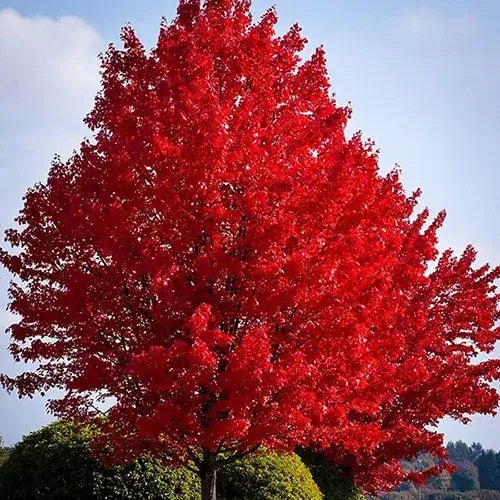The red maple tree is a quintessential symbol of vibrant autumn colors. It is known for its brilliant red foliage, which can transform any landscape into a stunning display of natural beauty. A versatile and hardy tree, it thrives across various climates in North America, stretching from the eastern U.S. to Canada. The red maple's charm lies in its color, adaptability, and resilience, making it a favorite choice for home gardeners and landscapers seeking a striking addition to their outdoor spaces.
How fast does red maple tree grow?
Red maples are considered moderately fast-growing trees, reaching growth rates of about 1 to 2 feet per year under optimal conditions. When young, their growth tends to be more vigorous, often providing noticeable changes in size from season to season. This steady rate of development allows homeowners to enjoy the benefits of a maturing tree without waiting decades for shade and color. Red maple trees can eventually reach heights of 40 to 60 feet, with some exceptional specimens surpassing 70 feet. Their expansive canopy, which can spread 25 to 40 feet, provides ample shade, cooling surrounding areas naturally.
For red maple to reach its full potential, it needs well-drained, slightly acidic soil and adequate water, particularly during its first few years. While the tree tolerates various soil types, including clay and sandy soils, it likes moist conditions. Supplemental watering is recommended to maintain steady growth in more arid regions or during dry spells. Once established, the red maple exhibits drought tolerance, although periodic deep watering encourages a healthier root system and enhances its resilience against adverse weather.
What is the best month to plant red maple?
The ideal time to plant a red maple is during the cooler months, with autumn being the preferred season. Early fall provides optimal conditions for root establishment before the ground freezes, allowing the tree to develop a sturdy foundation for the growing season. Alternatively, spring can also be a suitable time, especially if planting is done after the threat of frost has passed. The key is to avoid the extremes of summer heat and winter cold, which can stress young trees and hinder their development.
When planting in the fall, gardeners can take advantage of cooler temperatures and increased moisture in the soil. This environment encourages robust root growth without the demands of sustaining a full canopy of leaves, as the tree is typically dormant. A spring planting may also be successful, provided adequate watering is maintained during the following warm months. Ensuring the red maple has a good start will reward you with quicker growth and a healthier tree.
Is a red maple an excellent tree to plant in your yard?
Red maples make excellent yard trees, thanks to their relatively manageable size, rapid growth, and stunning seasonal color. These trees are known for their broad appeal, providing a canopy that offers substantial shade in the summer and a burst of scarlet in the fall. Their adaptability to diverse dirt types and climates makes them popular for homeowners looking for a low-maintenance yet visually impactful tree.
One of the red maple's most compelling features is its ability to thrive in urban settings. It tolerates air pollution and compacted soils better than many other tree species, making it suitable for residential landscapes, parks, and streets. Its shallow root system does, however, require some consideration, as planting too close to sidewalks, driveways, or foundations can lead to issues with surface roots. Proper placement, about 15 to 20 feet away from buildings, can help avoid these concerns.

Another advantage of the red maple is its wildlife value. The tree attracts various bird species, which seek shelter in its branches or feed on its seeds. Its flowers are among the first to bloom in the spring, providing an early food source for pollinators such as bees. The red maple's year-round interest-spring flowers, summer greenery, brilliant fall foliage, and even attractive bark in winter, ensures that it brings life and color to the garden across all seasons.
What is the best red maple tree?
Several cultivars of the red maple tree are well-suited for different landscape preferences, each with unique characteristics. The 'Autumn Blaze' cultivar is among the most popular, boasting a particularly vibrant red color in fall and a faster growth rate than many other varieties. Known for its durability, it can withstand varied environments.
Another notable variety is the 'Red Sunset' maple, which features an early and consistent red fall color alongside a dense, rounded canopy. This cultivar is prized for its strong branching structure, making it less susceptible to damage from storms or heavy snow. 'October Glory,' as its name suggests, holds onto its red leaves later into the fall than many other varieties, extending the colorful display well into November in some regions. It grows slightly slower than 'Autumn Blaze' but makes up for it with a more compact and manageable size.
The choice of cultivar depends on the desired aesthetic and specific landscape requirements. While the natural red maple blends yellow, orange, and red in fall, the cultivars selected for particular colors can offer more predictable results. Whatever the choice, the red maple's adaptability and visual appeal make it an enduring favorite among those looking to enrich their gardens.
In conclusion, the red maple is more than just a tree. It's a living work of art that enhances the beauty and value of a landscape. Its seasonal transformations, manageable size, and ecological benefits make it a flawless selection for homeowners seeking to make a bold yet harmonious statement in their outdoor spaces. When planted in the right conditions and cared for properly, red maple can provide a lifetime of enjoyment, adding color and character to the landscape year after year.









































































































